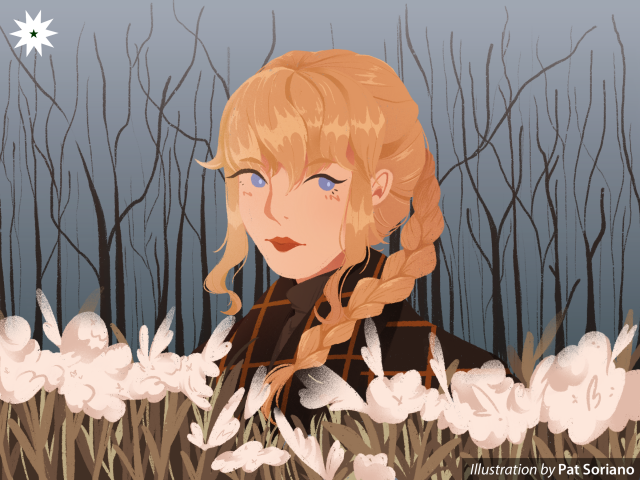
Every Taylor Swift era is a carefully-cultivated circus act. Every album rollout is meticulously planned—the aesthetic is distinct, easter eggs are slyly planted to build intrigue, and singles are primed for chart domination. The trademark red lipstick of the Red era, the glossy girl squad of her 1989 heydey, her outright refusal to make publicity appearances for Reputation—make no mistake, Swift is the clever puppet master tugging on all of these strings. She has machinated a seamless transition from country princess to popstar to indie songstress in the nine albums of her 13-year-career that shows no sign of stopping soon.
While this almost-omniscient creative planning played a huge role in cementing Swift’s place in the spotlight when so many of her peers have faded into obscurity, it has also taken its pound of flesh. Constantly having to reinvent herself, commercialize her private life, and top each album with a better one—all in order to keep her precarious place atop the high wire—not only has an emotional toll, but effectively limits her creative direction too.
In so many ways, Folklore is Swift’s great escape. Its surprise July release defied so many of her rules; not only is it an entirely new genre for the artist, but there was also no premeditated album rollout or catchy singles tailored for sold-out stadiums. For the first time, she has nothing to prove—to the fans, to the charts, to herself. Evermore is a continuation of this defiance; a wonderful toast to her newfound freedom as the sister record takes us to some strange magical places.
I know places
While the self-contained and sonically cohesive Folklore is shrouded in mystery as we wander into the metaphorical enchanted forest, Evermore is Swift making herself at home in a cabin in the woods, a cheery fire crackling in the hearth. No longer does she have to keep up the pretense of reinvention, as we see an eclectic blend of pop, country, and folk in the 15 songs in the album. She peruses her closet of discarded past selves, puts a few on, and twirls with the enthusiasm of a child playing dress up. Lover-era pop music influences color songs like Willow and Gold Rush, while Champagne Problems reminisces the confessional quality of Red.
Perhaps most notable is her return to her country roots with anthems like No Body No Crime and Cowboy Like Me, outfitted with all the bells and whistles and heavy with the vibrations of a mandolin. Both so evocative and tongue-in-cheek, you can almost picture the smoky midwestern karaoke bars they will most definitely be played in.
Wordsworth
No matter the genre or the album, Swift’s unparalleled lyrical abilities shine. Evermore is no exception, as she says so much with so little. “And it always leads to you and my hometown,” she softly trails off in sweet surrender to fate in ‘Tis The Damn Season. “You’re a bandit like me,” she croons in Cowboy Like Me—such a simple line for the heavy suggestion of finally meeting someone who understood your soul. Coney Island, co-written with The National and Joe Alwyn, is full of vivid imagery of a place time forgot—an apt setting for a relationship slowly imploding. Its most poignant line, “And when I got into that accident / The sight that flashed before me was your face,” is rife with the implicit inevitability of a doomed love you can’t quite get out of your head.
The magic of Swift’s writing lies in the exquisite narratives she weaves—so painfully human, so tragically flawed, and so joyful in spite of it all. “I hope she’ll be your beautiful fool,” she writes with enough vitriol in Happiness, before her feral delivery of the line “It’s the goddamn fight of my life and you started it,” in Ivy, harkening back to Cruel Summer’s high-octane, “I don’t want to keep secrets just to keep you.”
But Evermore’s best writing is Marjorie, penned in honor of Swift’s grandmother who passed away when she was 13. Soulful and raw, she paints an aching picture of grief and regret through amber skies and frozen swims; encapsulating how loss is tenderly felt even in the autumn chill. “And if I didn’t know better / I’d think you were talking to me now,” she sings with all the fervent hope of a child who doesn’t really believe in death yet, before following it with “Should’ve kept every grocery store receipt / ‘Cause every scrap of you would be taken from me.”
Are we out of the woods?
Evermore feels like the music Swift would have had eventually put out two decades from now had the pandemic not happened. It’s an intimate reflection on the place in life she has arrived at after being freed from the pressures of stadium tours and pop stardom. Exploring new territory while leaning on her songwriting strengths, Swift continues the rich mythology that made Folklore extraordinary.
While some may have concerns over her longevity since she started surprise dropping albums with no rollout or distinct eras, if there’s anything we’ve learned from Swift’s career, it’s that she’s got tricks up her sleeve.
Rating: 4/4
